Some pink ink about the cartoon character who is also a precious gem, a famous song, a series of movies and a recording star.

THE PINK PANTHER
Music from the Film Score
Henry Mancini and His Orchestra & Chorus
RCA Victor Records LSP-2795 (Stereo) LPM-2795 (Mono) (12” 33 1/3 RPM LP)
CD Reissue: Buddha 74465 99725 2 (2001), available for streaming and download
Record Store Day 50th Anniversary Pink Vinyl LP: #888433050811 (2014)
Released in 1963. Producer: Joe Reisman. Engineer: Jim Malloy. Recorded at RCA Victor’s Music Center of the World, Hollywood from September 16-18, 1963. Running Time: 29 minutes.
Instrumental: “The Pink Panther Theme,” “It Had Better Be Tonight (Instrumental),” “Royal Blue,” “Champagne and Quail,” “Village Inn,” “The Tiber Twist,” “Cortina,” “The Lonely Princess,” “Something for Sellers,” “Piano and Strings,” “Shades of Sennett” by Henry Mancini.
Song: “It Had Better Be Tonight” by Henry Mancini, Johnny Mercer, Francesco Magliacci.
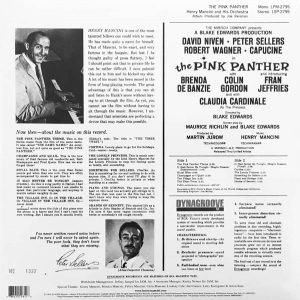 This album introduced the Pink Panther character and “The Pink Panther Theme” to long-playing records, in time for the release of the 1963 live-action “heist caper” comedy feature that initiated all that was to follow.
This album introduced the Pink Panther character and “The Pink Panther Theme” to long-playing records, in time for the release of the 1963 live-action “heist caper” comedy feature that initiated all that was to follow.
Like a certain floor wax/dessert topping, “The Pink Panther” is more than just one thing. The actual “pink panther” in the film story refers to a precious diamond first seen in the prologue. When the camera closes in on the gem, there is a gauzy dissolve to the animated title, upon which DePatie-Freleng Enterprises (also known as DFE Films) based the openings of their Pink Panther cartoons, beginning in 1964. Within the cartoons as well as the movie title sequences, the Panther is an animated character who has only rarely spoken and rides a fine line between surrealism and slapstick.
Peter Sellers became an international star as the clueless, accident-prone yet determined Inspector Clouseau in the first film and its sequel, which did not mention a “Pink Panther” in the title, but was called A Shot in the Dark (1964). This feature’s animated opening titles introduced an animated version of Sellers in the role. The character was redesigned for the second DePatie-Freleng “Inspector” theatrical series. Alan Arkin played the title role in the third feature, Inspector Clouseau (1968) which was not directed by Blake Edwards, but Bud Yorkin, who with creative partner Norman Lear would shortly produce the first of several pilots for what would become TV’s All in the Family. The animated Clouseau feature in this feature more closely resembled The Inspector of the cartoon series, who was voiced by Pat Harrington, Jr. (Dwayne Schneider of another Lear sitcom, One Day at a Time).
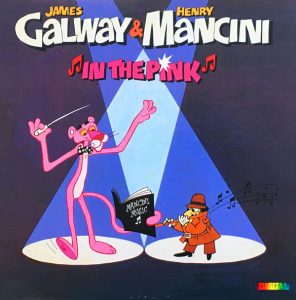 By 1975, long after DePatie-Freleng’s cartoon counterparts had taken on lives of its own, Peter Sellers came back to the big screen for the very successful Return of The Pink Panther. This film and its further sequels, all using “Pink Panther” in their titles, created a mindset that a “Pink Panther movie” was synonymous with an “Inspector Clouseau movie” at first because it starred Sellers and always because it had an animated title sequence with the cartoon Panther.
By 1975, long after DePatie-Freleng’s cartoon counterparts had taken on lives of its own, Peter Sellers came back to the big screen for the very successful Return of The Pink Panther. This film and its further sequels, all using “Pink Panther” in their titles, created a mindset that a “Pink Panther movie” was synonymous with an “Inspector Clouseau movie” at first because it starred Sellers and always because it had an animated title sequence with the cartoon Panther.
The cartoon Inspector made occasional appearances on record album covers, including a 1984 RCA LP called In The Pink with Henry Mancini and flutist James Galway. Also in the eighties, Kid’s Stuff Records produced a number of children’s records featuring The Pink Panther and The Inspector. The albums were explored in this previous Animation Spin.
Director Blake Edwards and DFE’s David DePatie recalled how it happened:
DAVID DePATIE: One day, the telephone rang and it was Blake Edwards. I went over to his office and he handed me this script called The Pink Panther. He said, “I want you to design for me a Pink Panther character.”
BLAKE EDWARDS: One of us suggested that we actually bring the Panther to life. It most likely was either me or my uncle, who was [a second unit director]on that. Owen Crump, who had a career at Warner Brothers and was very close to David DePatie and Friz Freleng. Once it was mentioned, then I can remember constantly sending telegrams back and forth about how I saw the character. I made up a background for the character.
DAVID DePATIE: So Friz and I went back to the shop and got some of our top designers together and we came up probably a week later with, I’d say, a hundred or more different variations on what a Pink Panther would look like. So we hauled all these over to Blake’s house one Sunday afternoon and laid them out on his living room floor, and he walked around and looked–and Blake is a very decisive guy–and what he did was, he went over and he pointed to this way says, “That’s the one I want. “The character was born.
Probably more than anyone else, including Friz and myself, Hawley Pratt made the major contribution to the Pink Panther because it was Hawley’s design that Blake picked that day. All he did with the character was, he put it on his production letterhead and, I think, on business cards, and that type of thing and that was it. I’d say three months went by and I got a telephone call again. Blake says, “Come on over.” He says, “David, I have the film in the can now and I know exactly what I want to do with this character. I want you guys to create an opening title sequence, a main title sequence, featuring the Panther.”
DAVID DePATIE: We take the picture out to preview. After the main title sequence is over with, they had turned on the lights and shut off the projector. People were jumping up and down in the aisles and applauding, and just it was screaming and yelling! I’ve never seen such a reaction. After that screening, I started to think, you know, there may be life after the main title. This character may have a place in animation.”
These are a few behind-the-scenes stories shared in Behind the Feline – The Cartoon Phenomenon, a 2003 video that is including among the pink plethora of audio commentaries and documentaries (many with our own Jerry Beck) in the six volumes of The Pink Panther, just released on Blu-ray (separately or as a set) and looking as crispy and bright as a bowl of Post Pink Panther Flakes.
“The Pink Panther,” as a theatrical cartoon series, is perhaps the last great ones of its era. It is certainly the last one with a direct connection to the early days of animation by way of Friz Freleng, who was not only a great Warner Bros. cartoon director, but was also an artist from the early days of Walt Disney and MGM, even before cartoons had sound and color.
The series also was, according to veteran animator/director Art Leonardi, the “Pink Power” that drove the DePatie-Freleng studio during its highly unique boutique run of theatrical shorts, TV series, commercials and iconic titles—including this one (after the introductory Paul Frees version):
David DePatie was a Warner executive in charge of TV ad placement (for shows like Maverick) before he was assigned to Warner’s animation studio. He oversaw such projects as The Bugs Bunny Show segments and 1964’s The Incredible Mr. Limpet. But as the latter was in production, Warner decided to shutter the cartoon studio. DePatie partnered with Freleng and rented space on the Warner lot, continuing to produce cartoons with Warner characters, as well as other projects. All of this is detailed further in Think Pink! The DePatie-Freleng Story by Mark Arnold.
It would stand to reason that The Pink Panther titles and cartoon series were music driven. Friz Freleng had a musical background and was responsible for some of the most memorable music-related Warner Bros. cartoon classics, including Three Little Bops, Rhapsody in Rivets and Rhapsody Rabbit. Once DePatie-Freleng was handed the title assignment for Blake Edwards’ 1963 live-action heist caper comedy starring David Niven, Peter Sellers and Capucine, among his first steps was to approach Oscar-winning composer Henry Mancini about the music he was planning. Mancini had not worked the theme through yet, but he provided the beats, and that is what Freleng used to make the titles.
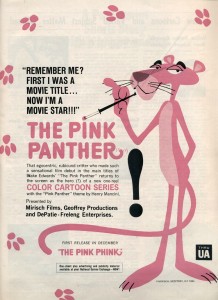 “The Pink Panther” has yet another renowned identity as a piece of music and a series of recordings. The theme is probably Henry Mancini’s most recognizable composition among hundreds of scores for film, TV and stage. (He can be seen applauding both the musical and animated “Panthers” in the 1966 short, Pink, Plunk Plink.) The DePatie-Freleng cartoon image of the Pink Panther is usually somewhere on albums that features the theme itself, related film scores (there were several sequels and remakes) or Mancini music compilations.
“The Pink Panther” has yet another renowned identity as a piece of music and a series of recordings. The theme is probably Henry Mancini’s most recognizable composition among hundreds of scores for film, TV and stage. (He can be seen applauding both the musical and animated “Panthers” in the 1966 short, Pink, Plunk Plink.) The DePatie-Freleng cartoon image of the Pink Panther is usually somewhere on albums that features the theme itself, related film scores (there were several sequels and remakes) or Mancini music compilations.
“The Pink Panther Theme” as heard in the short cartoons was not arranged and conducted by Mancini but first by William Lava, a staff composer at Warner Bros. who was also scoring later Looney Tunes produced by DePatie-Freleng. When DFE moved off the Warner lot (first to a Union Bank building that makes an appearance in 1969’s Think Before You Pink), Walter Greene handled most of the scoring, followed by DePatie’s son, Steve. All of these scores interpolate the Mancini theme into various music cues, along with other bits of music that do not use the theme.
When The Pink Panther Show came to television in 1969, Doug Goodwin wrote and performed what would be a succession of catchy theme songs for various series incarnations. Goodwin became a musical mainstay of DePatie-Freleng, but his first big break came at Hanna-Barbera when he wrote songs for Hey There, It’s Yogi Bear and The Man Called Flintstone, on the recommendation of Freleng, who was working on the Yogi feature at the time. We’ve explored some of Goodwin’s work in previous Animation Spins, this one for The Bear Who Slept Through Christmas, the Goldilocks TV special soundtrack with Bing Crosby and the groovy “Grasshoppers” album based on the Doctor Dolittle series (note the Leonardi cover art and lettering).
“The Pink Panther Show”
This was Goodwin’s theme song for the Panther’s 1969 NBC Saturday morning debut, featuring the “Pink Panthermobile” by George Barris, designer of such custom classics as the Batmobile, the Munster Koach and My Mother the Car’s 1928 Porter.
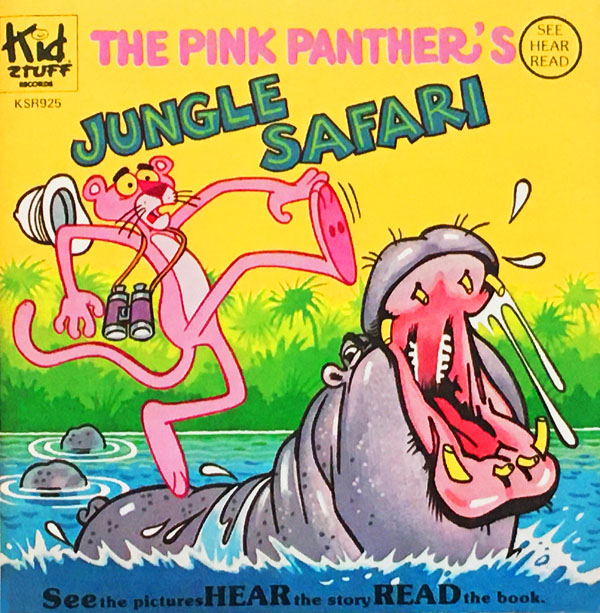
PINK PANTHER
READ-ALONG BOOK & RECORDING SETS
Kid Stuff 7” 33 RPM LP Records or Cassettes
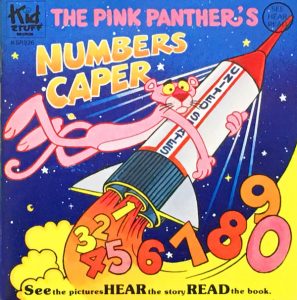 KSR-925 The Pink Panther’s Jungle Safari (1981 / 11 minutes)
KSR-925 The Pink Panther’s Jungle Safari (1981 / 11 minutes)
KSR-926 The Pink Panther’s Numbers Caper (1981 / 12 minutes)
KSR-981 The Pink Panther Fun Book (1982 / 6 minutes)
There are very few records related to DePatie-Freleng cartoons. None of the music or any other audio material from Pink Panther cartoons were commercially released in soundtrack form. But the popularity of the Pink Panther as a merchandise license was such that Kid Stuff Records managed to produce a stack of vinyl albums and read-along recordings about him. The Kid Stuff Pink Panther LPs are described in this Animation Spin.
Like the albums, the seven-inch read-alongs are narration-based because the Panther is a pantomime character, but at least a read-along book provides a greater number of visuals, even if in this case they are very simple, lower-cost line drawings, excusing them as “coloring pages.”
These three titles were produced at time in the Kid Stuff era before the label began to released read-alongs with full-color books. Jungle Safari and Numbers Caper are educational lessons with a Pink Panther adventure to tie the elements together.
“The Pink Panther Fun Book”
The third of the three Pink Panther Kid Stuff read-along is narrated by The Inspector (voice actor uncredited), guiding the listener through various adventures as a way to set up the activity pages.
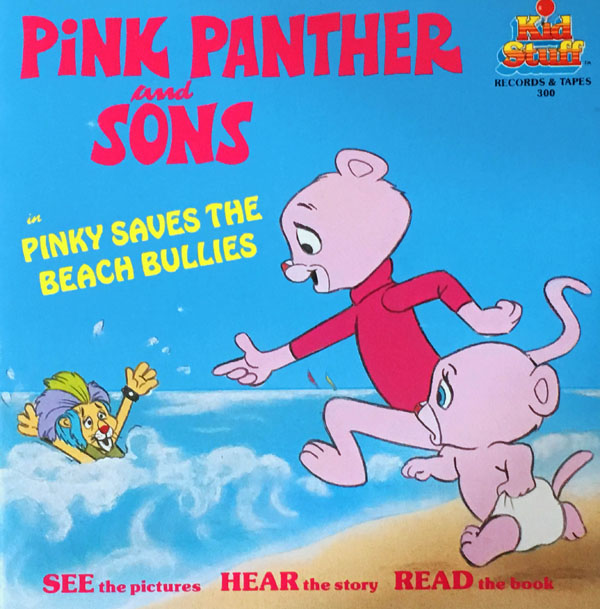
PINK PANTHER AND SONS
READ-ALONG BOOK & RECORDING SETS
Kid Stuff 7” 33 RPM LP Records or Cassettes
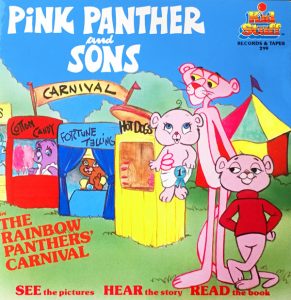 KSR-299 The Rainbow Panthers’ Carnival (1984 / 14 minutes)
KSR-299 The Rainbow Panthers’ Carnival (1984 / 14 minutes)
KSR-300 Pinky Saves the Beach Bullies (1984 / 14 minutes)
Pink Panther and Sons (1984-1986) was the first TV series with the character, produced at Hanna-Barbera Productions in association with DePatie-Freleng (and Mirisch-Geoffrey who co-owned the character). Friz Freleng was Creative Producer. But four years earlier, DePatie-Freleng Enterprises as a company had already become Marvel Productions (not to be confused with today’s Marvel Studios) in 1980. The DFE staff had been merged into the Marvel culture and personnel and Friz Freleng retired in 1983.
“Of course, Stan Lee is Stan Lee, and I think he became a very big voice and in the transition to Marvel because of all his characters and all his approach,” recalled layout artist Martin Strudler. “There were almost two studios… we’re in the same building and everything, but we didn’t interact artistically at all.” The transition period is chronicled in Mark Arnold’s aforementioned Think Pink! book; Strudler’s interview and many others can be seen in the short documentary called Tales of Production (and Production Overload), included on both The Dogfather and Misterjaw Blu-rays.
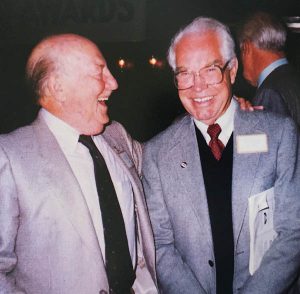 Freleng came out of retirement in 1984 to do Pink Panther and Sons. He had been friends with Bill Hanna and Joe Barbera since the thirties when they worked at MGM’s animation studio. David DePatie participated in the series as well, before retiring in 1984.
Freleng came out of retirement in 1984 to do Pink Panther and Sons. He had been friends with Bill Hanna and Joe Barbera since the thirties when they worked at MGM’s animation studio. David DePatie participated in the series as well, before retiring in 1984.
“A lot of footage had gone through the projectors since the days when Friz and I had worked with rather disgruntled diligence on the old Captain and the Kids pictures during that period much characterized by Joe Barbera and me as ‘BTJ’ (‘Before Tom and Jerry’),” recalled Bill Hanna in his 1996 autobiography A Cast of Friends. “Having Friz on the lot helped bring back memories of the callow excitement of those sophomore years,” wrote Hanna. “Despite the fact that he was pushing eighty around then, Friz was still one of the best animation directors in the industry. He was with us at H-B for two years.”
The Pink Panther and Sons half-hour was designed to showcase the new and the classic alongside each other, so both the original cartoons and the “reimagined” segments were alongside each other in the same show, a highly unusual and mutually respectful concept for a reboot. The series premiered on NBC and was picked up by ABC.
Kid Stuff Records adapted two softcover Golden Books into Pink Panther and Sons read-alongs. The label, which by 1984 had become an aggressive contender in the children’s record market with a competitive roster of major licensed characters, was now providing higher-quality, full-color books like their competitors. The recorded output itself continued to be uneven in scope.
“Pinky Saves the Beach Bullies”
The story is performed by uncredited actors with an original theme not connected to the TV series. It’s done in a very low-key, homespun style.


 GREG EHRBAR is a freelance writer/producer for television, advertising, books, theme parks and stage. Greg has worked on content for such studios as Disney, Warner and Universal, with some of Hollywood’s biggest stars. His numerous books include Mouse Tracks: The Story of Walt Disney Records (with Tim Hollis). Visit
GREG EHRBAR is a freelance writer/producer for television, advertising, books, theme parks and stage. Greg has worked on content for such studios as Disney, Warner and Universal, with some of Hollywood’s biggest stars. His numerous books include Mouse Tracks: The Story of Walt Disney Records (with Tim Hollis). Visit 






















































The original “Pink Panther” feature film is surprisingly adult in tone and content. It is actually a bedroom comedy, with Inspector Clouseau clueless about his wife’s infidelity, even when it is going on right under his nose. And yet there are broadly comedic bits scattered throughout the film that could appeal to adults or children.
The intent of who “The Pink Panther” films are intended for is thus somewhat blurred. The theatrical shorts appear to be designed for all ages to enjoy, while the feature films are primarily adult in nature, going by the PG or PG-13 rated language and the adult situations. And yet, there is the Pink Panther to bring a sense of juvenile humor to the proceedings. I would not describe any of the entries in the original feature film franchise to be exactly family-friendly. Not to disparage the work of Blake Edwards and Peter Sellers, which is of course brilliant. By comparison, the Steve Martin films are more toned-down. But not to disparage those, either. I personally enjoy most if not all of the theatrical feature films based on the pastel-hued feline. But the question remains of who they are intended for. I guess the best answer is–anyone who enjoys cartoons, slapstick humor, cartoon-style violence, adult themes and adult language all blended together.
Later efforts such as the “Pink Panther and Sons” series are so definitely aimed at children that it’s easy to forget the Panther’s more “adult” origins. Also worth noting is the continuation of the Pink Panther as a theatrical short cartoon series long after the other cartoon studios had boarded up their doors. New theatrical Panther cartoons continued well into the 80’s. Proving that the character has truly universal appeal that transcends the generations.
I re-watched the first Pink Panther about a year ago. I had forgotten how little Clouseau is in the film, and when he IS on screen, he’s not nearly as funny as the subsequent films. A Shot in the Dark rightfully made him the focus, and is a stronger film as a result. My favorite of the series is still The Pink Panther Strikes Again, though.
Your remark on how little Sellers is actually in the 1st film is so spot on….a classic case of a nearly supporting character becoming the star in most people’s minds….when they shoe horned Clousseau into A SHOT IN THE DARK, an old stage farce that had been filmed before, it proved the point that Sellers had become, and still is to many people, the name most associated with the franchise…. now I want to revisit the 1st one, just to see the billing order in the credits, which I assume had Niven first and maybe Wagner next….
Just an update…..Sellers is 2nd billed above Wagner and Capucine…..I suppose his star was rising from films that penetrated the US market, like MOUSE THAT ROARED or LOLITA….does anyone have any real idea of his comparative status before, or indeed after, PINK PANTHER….I’m always fascinated by the sea change in public profile by certain actors, Sean Connery for example, due to a certain role or even some non film related issue that raises, or lowers, reputation…..
Sellers was not yet the star he became as a result of The Pink Panther. He was not even the first choice to play Clouseau, as Peter Ustinov was the original choice.
The Pink Panther, and Dr. Strangelove from the same time, really put Sellers on the map in the US and possibly the world. He had a reputation for being rather impossible to work with, which must have been a factor in his decline in the late ’60s – he was originally the star in the 1967 Casino Royale, but quit/was fired during production (and still got top billing), leaving them to piece together and rewrite what they could. Animosities aside, his movies with Blake Edwards, The Party and the Pink Panther films, were his critical high points afterward.
One of the big thrills of my teen years was seeing Henry Mancini in concert. Of course it was wonderful to see him conduct the Pink Panther theme, which I had learned to play on the piano when I was around nine, but for me the highlight was the original composition for two flutes and orchestra that he performed with James Galway. Mancini was an outstanding flutist.
I took a composition seminar in college, and one of the guest speakers was the Principal Horn of the Dallas Symphony Orchestra, who talked about writing for brass instruments. When someone asked him to name which composer he thought was best at writing for brass, he eschewed the usual suspects (Wagner, Bruckner, Mahler) and without hesitation said it was Henry Mancini. He had recently done a concert with Mancini and was very impressed with the elegance and sophistication of his charts. A composer could learn a lot about orchestration by studying Mancini’s work, he said. At this point two of my professors started rolling their eyes and did everything but get out the big hook in their haste to hustle him off and bring the seminar to a close. The funny thing was, both of these professors were trumpet players with backgrounds in jazz. I don’t know what their beef against Mancini was, but I think the guest speaker was right and wish he had been allowed to go into greater depth.
I can think of one composer who benefitted from familiarity with Mancini’s scores: John Williams, who worked with him during his days as a session musician. That’s Williams playing the famous piano riff at the beginning of “Peter Gunn”.
There was a Pink Panther Flakes cereal in the early ’70s. Basically it was sugar frosted corn flakes dyed pink, but it also had the effect of turning the milk pink, which was pretty cool. The TV commercials started with the Henry Mancini theme, then segued into the Doug Goodwin theme, with new lyrics sung by a female voice. “We love those one-two-three-four-five-six-seven-eight different vitamins, just as much as we love you. From Post!”
I’ve long known that DePatie-Freleng made the “I Dream of Jeannie” opening title, just as Hanna-Barbera made the one for “Bewitched”. But does anyone know who made the animated opening titles for “Lost in Space” and “My Favorite Martian”?
I remember those early 70s Post Pink Panther flakes,and,yes, strictly “Kellogg’s Frosted Flakers” flavored, but pink,same taste. Pink Panther and Sons basically had NO connection to the original, just another 80s Care Bear show with panthers.Thanks for the article.Tom, that was funny!
Another outstanding column and even though you make it look easy and seamless, I know how difficult it is to do research on something like this topic and try to sort out the actual facts from the publicity hype. I am not even going to mention that you failed to include Jerry Beck’s book Pink Panther: The Ultimate Guide to the Coolest Cat in Town or Hope and Sybil Freleng’s (Friz’s daughters) Meet the Pink Panther as something for further exploration for those who are interested. Always impressed with your details and the ease in reading what you write. You always share lots of stuff I never knew. Thanks.
What an informative and fun article. Frederick asks who the audience is supposed to be. First and foremost, it’s the French. Obviously! Detective Cuseaux and his wandering wife. Just, so French.
I think these people love being interviewed by you Greg. You let them tell their stories.
Thanks, Tom.
While many interviewees have indeed been pleased with my interviews of them for other projects, just pointing out that the interviews in this article are not mine, but from the Blu-ray bonus features. Bill Hanna’s quote is from his book.
Your kindness and consideration are especially appreciated, Tom.